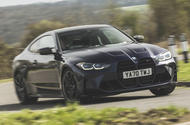
It’s bigger, brawnier and gawkier than ever. Can the new M4 cut the mustard?
Whether you think of this week’s test subject as the second generation of a particular M division performance coupé or as a de facto sixth-generation version of an even more influential one, we can probably all agree that the arrival of the new BMW M4 Competition represents a significant moment for enthusiasts and keen drivers the world over.The M4 is the modern inheritor of the legacy of that oh-so formative M3 homologation special of 1986 and brings with it plenty to talk about besides its styling – which, like that of so many modern BMWs, is intended to divide opinion.The days when driver’s cars of this size and brief were powered by high-revving atmospheric engines of the kind that various celebrated M3s have had over the decades are gone. But we have yet to see a partially – or even fully – electrified M car, so where does that leave the M4 Competition? Don’t imagine it’s nowhere.The G82-codenamed M4 has a new engine, and while it may not be a free-breathing V8, it does produce significantly more power and more accessible torque than even the hardcore BMW M4 GTS of 2015 had.The car also gets a drivetrain unlike that of any compact M car before it. You can have a rear-wheel-drive, manual gearbox-equipped M4 in some markets (but the UK isn’t one of them). Otherwise, you can have one with an eight-speed automatic gearbox or even, in a significant break from this car’s acknowledged technical template, with four-wheel drive, with xDrive M3s and M4s due to join rear-driven ones here in the UK later this year.Whether you choose one driven axle or two, this car should be able to hit 62mph from rest in less than four seconds. But has it got the classic BMW M car driver appeal to match?BMW M4 Competition design & stylingWith its gaping nostrils, fussy lines, weedy stance and awkward rear, the M4’s looks attracted criticism from all of our testers.And while the initial shock that accompanied our first look at its beaver-fanged face may have subsided over time, in no case did that clear a space for affection. Some will undoubtedly like this car’s bold and unapologetic styling, but plenty won’t.The M4’s mechanical specification is far easier to take to heart. The car’s 3.0-litre, twin-turbocharged S58 straight six engine is new, and it’s a force to be reckoned with. It makes 503bhp from 5600-7200rpm and 479lb ft between 2750rpm and 5500rpm, all of which was deployed in our test car’s case to the rear wheels via an eight-speed ZF automatic transmission and an electronically controlled limited-slip differential – although, as we’ve already mentioned, other driveline configurations are now available.Suspension is by way of special M division axles comprised of new aluminium wishbones up front, multiple links at the rear and adaptive dampers all round. Plenty of work has gone into strengthening and stiffening the standard BMW 4 Series’ chassis and lightening its body, too; as before, there’s a carbonfibre roof as standard to help lower the car’s centre of gravity.All of which is welcome, because the M4 is bigger than ever. Its predecessor was already a large car, but this new one is 123mm longer, 17mm wider and – on our test scales – a hardly insignificant 190kg heavier. However, BMW has been better able than before to spread that mass across the M4’s axles. We found the old car to have a 53% front, 47% rear weight distribution, while new model splits it right down the middle.The BMW 4 Series line-up at a glanceThe 4 Series line-up is a relatively diverse one. Non-M division models are available in both coupé and convertible bodystyles, with a choice of four-cylinder or six-cylinder petrol engines, or a sole four- cylinder diesel. Rear-wheel-drive and all-wheel-drive models are both available, too, although all 4s sold in the UK come with an eight-speed ZF automatic transmission.For now, the M4 Competition is only available as a coupé, though a four-door Gran Coupé and a convertible will no doubt join the line-up in the near future.
Source: Autocar